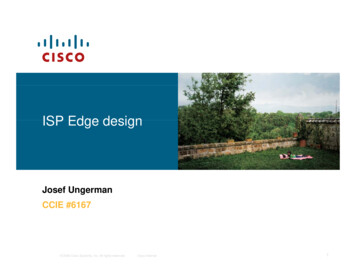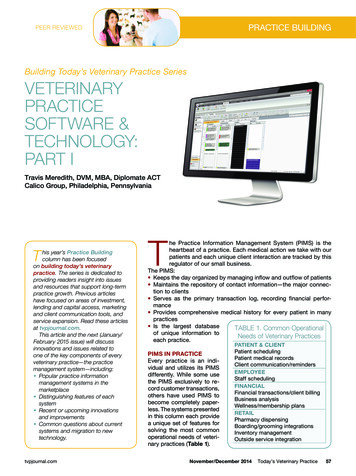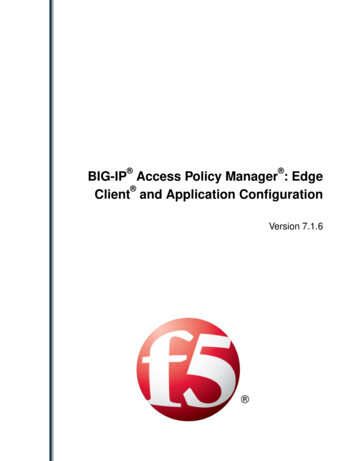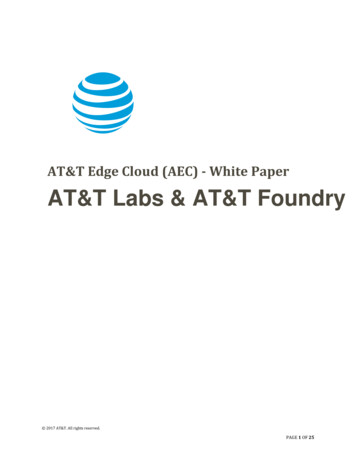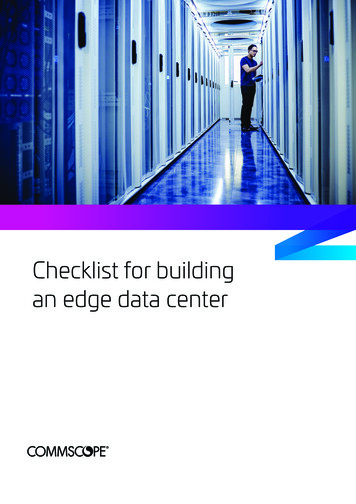
Transcription
Checklist for buildingan edge data center
Building an edge data center to providea cloud computing environment withina service provider central office can be acomplex endeavor.It requires lots of planning and preparation to ensure that it can deliver the necessary endgoals. Service providers are increasingly moving towards leveraging the architecturesand technologies of software-defined network (SDN) and network function virtualization(NFV) to be more agile—bringing new services online faster, and saving on both CapEx andOpEx through efficiencies. Convergence of wireline and wireless networks, and the needfor higher bandwidth with lower latency is driving the cloud computing environments tothe edge of the networks. Central offices (CO) are typically on the network edge as that iswhere the access network (fiber optic cables) terminate, and thus are prime locations foran edge data center. Because cloud computing and SDN/NFV technology is constantlyevolving, the edge cloud computing environment design and supporting fiber infrastructuremust take into consideration what the future may bring and how this new environment or“edge data center” might take advantage of this.To help plan a successful edge data center, CommScope has created apreliminary checklist and tips to consider for:1. Location4. Design2. Power5. Physical Infrastructure Layer3. Heating and Cooling2Checklist for building an edge data center
1. LocationLocation refers to both the geographic area where a service provider plans to place or build an edge data center andthe actual physical site itself. Once a possible site has been identified that seems to satisfy the requirements, thenext step is to determine if the potential building can accommodate the needs of an edge data center. What is the best location for the edge data center?– How close is it to the desired target market? Is the geographical location prone to natural disasterssuch as earthquakes, floods, hurricanes, tornadoes, icestorms or excessive heat? How much square footage is available in nearbyexisting facilities or central offices?–– If an existing site has limited room, is there room outsideof the building that can house a modular data centersolution? Or, is there an opportunity to retire andremove old equipment? How many racks or cabinets initially will be installed?–– – What will the data center look like 3 to 5 years fromnow? Does the building already have anyinfrastructure already in place?–– – If not, how easily can this building be retrofitted? Does the building currently have sufficient power?–– – See Power below for questions to consider. Does this building have adequate heatingand air conditioning?–– See Heating & Cooling below for more questionsto consider. Can the building obtain multiple high-speednetwork links?–– Ideally, network connections should enter and exit atdifferent points in the building. Does the building have a lot of windows?–– Windowless facilities are best to better control indoorclimate and security. Are pathways such as doors, aisles, hallways andfreight elevators large enough for equipment,racks and/or cabinets to be moved in and out? Do regulations or internal rules require that theedge data center area be physically separatedfrom the rest of the telecom space in for examplean existing central office? Does the edge data center space need to be separatedby a physical firewall?2. PowerPower planning for today and for the future is one of the most critical items in the edge data center. To ensure theedge data center is always operational, consider redundancies that meet the service provider’s requirements andplan accordingly. Can the utility company or multiple companies provideenough power now and in the future? Can the building be serviced by multiple utility grids?–– In a best-case scenario, power should enter the facilityfrom different entrance points. Can power be supplied directly or will conversionequipment be required?–– Consider conditioning the electrical power to avoidspikes or surges. Is there enough back-up power from the generators? How many uninterrupted power supplies (UPSes)have been planned to be used?–– UPSes should support the entire infrastructure for atleast 150% of the time it takes for generators tocome online. What is the average power requirement per rackor cabinet?–– Typical data center racks require 5-10 kW of powerwhile ultra-high density racks may need up to50-60 kW.–– Generators should be able to support the edge datacenter for at least 48 hours during a power outage.Checklist for building an edge data center 3
3. Heating & CoolingHeating, venting and air conditioning (HVAC) is essential to the successful operation of a data center. Since nearly50 percent of all power used by a data center is eaten up by HVAC, making this function as efficient as possible isvital to OpEx. How many BTUs can the space/building support?–– Ideally, the ambient temperature should remain around70 –74 F (21 –23 C) with 45–50 percent humidity. How will the data center’s temperature be monitored?–– Utilizing temperature sensors on the racks are the bestway to monitor temperature. How will the data center be cooled? Consider a plan to minimize climate control costs.–– Adopting a free-cooling design can also be a costeffective solution to temperature control. Consider walling off or utilizing curtains to bettercontrol the climate off the data center equipment.–– Controlling humidity and dust is critical to healthyservers and switches.–– Using a hot-aisle/cold-aisle design can simplifytemperature control.–– Raised floors must be constructed if cooling the datacenter from below.–– Slab floors can work well too, but often require in-aislecooling solutions4. DesignWhether converting a telecom site like a central office or building a data center from scratch, one crucial part ofdesign is planning the infrastructure. The following are a few questions regarding overall design and security. Does the data center design account for lighting? Does the facility have enough fire alarms and escapes?–– LED lighting uses the least amount of power and–– Local codes inform how fire safety preparations shoulddoesn’t generate heat. Is there a plan to secure the physical premises?–– Consider biometrics in addition to key cards for an extralayer of security. Consider a way of protecting rows or racks ofequipment from visitors if creating a customerco-location area.4Checklist for building an edge data centerbe made. What kind of fire suppression system is right forthe data center?–– To prevent expensive equipment from getting wet,special inert gas fire-suppression systems are oftenemployed.
5. Physical Layer InfrastructureTo gain maximum benefit of cloud computing and software-defined networking/network function virtualization(SDN/NFV), the physical layer of the edge data center must be seriously examined. Since the lifecycle of mostSDN/NFV equipment lasts about every 2–3 years, planning of the physical layer infrastructure to supportfuture technology and connectivity is essential.CENTRAL OFFICEHigh LowSpeed SpeedIOIOPhysical Network FunctionEDGE DATA CENTER WITHIN COSpine cessNetworkBLeaf SwitchesODFEdge Devices Consider a phased 3 to 5-year roadmap for the datacenter architecture.–– The physical layer infrastructure should be designed tosupport multiple upgrades— with migration paths thatcan support up to at least 400G. Because many carriers/service-providers will buildcomponents are installed, our unique link loss calculatorconfirms the correct installation. Our link loss/ fiberperformance calculator can be downloaded for free. The data center should easily support both duplex andparallel applications.–– Consider CommScope’s MPO-24 with LazrSPEED OM5the majority of their SDN/NFV or Cloud/ computeto provide duplex and parallel fiber value and migrationenvironments on the edge of the networkflexibility. The MPO-24 solution offers multiple parallel(CO, MTSO, CRAN Hub, regional DC), the size and(MPO-8, MPO-12 or MPO-24) and/or duplex ports via ascale of these environments should be such that thesingle MPO-24 trunk.physical infrastructure requirements can be supportedFor additional information on CommScope’s High Speedby multimode fiber optic cabling.Migration fiber infrastructure solutions please go to: Data center designs that propose longer channel pathsor extra connections should consider components thatwww.commscope.com/hsm/ Is there a plan to manage the infrastructure and itsadhere to loss budget parameters.connectivity as the data center grows?–– CommScope’s unique design tools can help speed and–– Consider using automated infrastructure managementsimplify design and planning. Our application support(AIM) systems to help the data center become moreguidelines provide the supportable distance limitsefficient—from tracking down ghost ports or switchesfor every supported application based on fiber type,and loose connections to providing detailed mappingconnector type and number of connectors. Once thefor moves, adds or changes.Since there is so much that goes into planning and designing an edge data center, this checklistcannot possibly cover every detail of any given project. CommScope and our PartnerPRO network of local experts around the globe would be happy to work with you to make sure that aservice provider’s future edge data center becomes everything they want it to be.Checklist for building an edge data center 5
CommScope (NASDAQ: COMM) helps design,build and manage wired and wireless networksaround the world. As a communications infrastructureleader, we shape the always-on networks of tomorrow.For more than 40 years, our global team ofgreater than 20,000 employees, innovators andtechnologists has empowered customers in allregions of the world to anticipate what’s nextand push the boundaries of what’s possible.Discover more at commscope.comcommscope.comVisit our website or contact your local CommScope representative for more information. 2018 CommScope, Inc. All rights reserved.Unless otherwise noted, all trademarks identified by or are registered trademarks, respectively, of CommScope, Inc. This document is for planning purposes only and is not intended tomodify or supplement any specifications or warranties relating to CommScope products or services. CommScope is committed to the highest standards of business integrity and environmentalsustainability with a number of CommScope’s facilities across the globe certified in accordance with international standards, including ISO 9001, TL 9000, and ISO 14001.Further information regarding CommScope’s commitment can be found at y-and-Sustainability.CO-111612.1-EN (03/18)
Checklist for building an edge data center 5 5. Physical Layer Infrastructure To gain maximum benefit of cloud computing and software-defined networking/network function virtualization (SDN/NFV), the physical layer of the edge data center must be seriously examined. Since the lifecycle of most SDN/NFV equipment lasts about every 2–3 years, planning of the physical layer infrastructure to .
